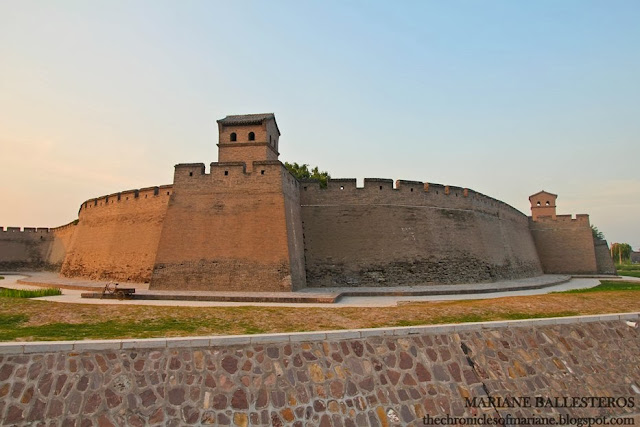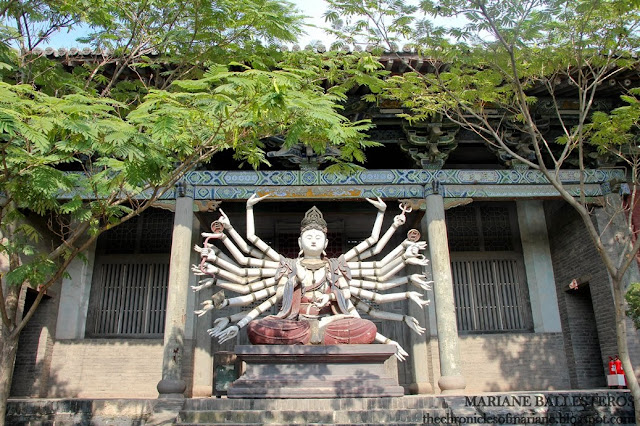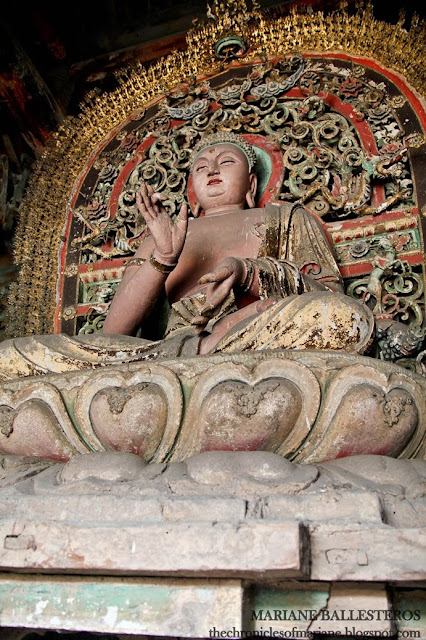My trip to Pingyao has been quite interesting so far, and it’s not about natural landscape that has charmed me, but the preserved ancient man-made buildings and structures that show a lot about China’s traditional way of living.
After a day of wandering around the Old City, I decided to join a group from my hostel who planned for another day trip on some attractions around the Shanxi countryside.
 |
| Entrance to Wang Family Compound |
The “tour” was pretty basic,
same as what I had in Datong, for three tourist spots I paid 100 CNY which was okay considering the distance of these places. When we arrived on our first destination, I learned that there was no English guide available. Might be a bit hard to navigate around without a guide as you could get lost on this labyrinth-like house complex, but I was able to manage.
 |
| the layout of the houses, see how massive this is! |
Our first stop was at
Wang Family Compound (王家大院
Wángjiā dàyuàn) located at Lingshi County, 35 kilometers from the Ancient City. This colossal and extravagant compound contains a series of luxurious residential buildings that belonged to the Wang Family built around Qing Dynasty and has been the home to one of North China’s wealthy and influential Jin merchants. Comprised of approximately 230 courtyards and 2,078 houses, it actually appears like a small city rather than a house containing five alleys, five fortresses and five ancestral halls.
The Wangs used to live in Taiyuan and moved afterwards to Lingshi after gaining more wealth from their daily trading. They became powerful in terms of business and politics so the family continued to prosper, resulting to a larger extended family, which resulted to the creation of this house compound. But during the Cultural Revolution, these wealthy landowners and aristocrats had to sacrifice their wealth due to the laws imposed by the Communist party. Their assets were distributed to the masses and so the Wang’s had to leave their home and was later on replaced by the villages. Because the family were good-natured, the villagers took care of the place and ensured that it was well looked after. As the Cultural Revolution ended, the villagers vacated the compound and it has been empty since.
 |
| lovely houses |
 |
| intricate wood carving details in the windows and doors |
 |
| can't help but take a "selfie" on this quiet house |
 |
| red theme, it would signify that the major family member sleeps in this room |
 |
| kitchen/dining area |
 |
| library is off limits to visitors |
The 150,000 square meter complex is laid out in a rectangle shape, quite different to other courtyards in China. The great mount of artistic architectural elements are also a treat to visitors, numerous elaborate carvings and sculptures are visible at almost every inch of the place that also signify some symbol or feng shui.
 |
| i love these tiny intricate details! |
 |
| grinning cats are said to be a sign of longevity |
 |
| colorful woodwork |
 |
| wood art details, so detailed |
 |
| zodiac animals are everywhere in the compound |
 |
| old china dinnerware that are hidden to most of the tourists |
 |
| this and the below image are one of the two wonderful wall reliefs that symbolizes different aspects of the Chinese culture and nature |
 |
| can you believe all of this belonged to only one family?! |
 |
| off to Zhangbi... |
 |
| goats randomly appearing! |
Nearby
Mianshan is another quiet but fascinating small town called Zhangbi Ancient Village, but more commonly known as the Zhangbi Ancient Castle (张壁古堡
Zhāngbì gǔbǎo) of Jiexu City, Shanxi built as early as 617 AD. Said to be included in China’s ten most charming towns, it flaunts of China's simple ancient architecture and is also famous for its rare underground defense system built during Sui Dynasty.
 |
| entrance to the village |
 |
| watch your step on these old cobblestones streets, you might step on "something" |
It is a fully functioning town with more or less 2,000 residents, few temples and buildings scattered around the area, but for me, one of its charms is the simplicity and tranquility of the area. Zhangbi does not receive too much guests so one can definitely enjoy the serene setting. Getting a guide is a must because they’d help you fully appreciate the neat and hidden gems that you wouldn’t be able to notice if you went here alone. Concepts from Chinese astrology were mostly used during the development of the town: from its name down to the village layout can have its history traced from the Zodiac.
 |
| Zhangbi Ancient Castle |
There is really not much to see here, but the main attraction is what most tourists go here for. 20 meters below ground of this quiet town lay an underground tunnel that goes as far as 1.5 kilometers. This interesting maze of three layers was supposed to be an evacuation center in case of invasion, it conceals rooms serving a different purposes: trap doors and secret passages, prison and killing rooms, communication facilities, weapon and food storage, and sleeping quarters for the higher-ups of the military. It may sound like a simple place for refuge, but the dim lights on the passageways gives a really eerie atmosphere. We were told that this tunnel was never employed for its intended use as the invaders left and evacuated the area after some time. Nevertheless, this intricate defense system is a rare ancient underground military site that is a must see for history buffs.
 |
| underground military system of Zhangbi |
Last to slash off my list was Shuanglin Temple (双林寺
Shuānglín Sì) of Qiatou Village situated six kilometers southwest of Pingyao's ancient city. The complex covers an area of 15,000 square meters that do not just serve a purpose as a temple, but more of a museum most notable for its collection of more than 2000 colorful sculptures that reflect the exquisite and superior skills of artisans from the Tang, Song, Yuan, Ming and Qing Dynasties. The temple is said to be constructed during the Northern Wei Dynasty, аbоut the same tіme thаt the
Yungang Grottoes of the same province were also being sculpted. Being listed as a UNESCO World Heritage site, I am actually surprised on why the place was literally empty when I got there.
It is just a bit disappointing that you cannot fully appreciate the sculptures with the bars hindering them and limited lighting conditions so even though the place prohibits taking of pictures, I allowed myself to take some making extra note not to use flash as too much exposure to light can aid to damaging these wonderful pieces of art, believe me, it will be hard for me to really grasp the essence of the temple if not for zoomable pictures, there is just too many elaborate details that one could miss.
These ancient terracotta and wood sculptures include various images of Buddha, Bodhisattva, deities, heavenly kings, warrior guardians and common people that almost seemed life-like with their vivid colors, expressive poses and the excellent workmanship, all of these have left me in awe. The temple is definitely one of a kind and is also one of the places in Pingyao that shouldn’t be missed.
 |
| one of the temples that feature warrior gods with intense facial expressions |
 |
| Fertility god |
 |
| this one is super creepy, legend has it that a girl once fell ill and was cared for by an old woman, they have been objects of worship to represent the value of loyalty. It is said that the body of the girl in that tale is encased in that "sleeping" sculpture!!! Yikes! |
 |
| small warrior figurine |
 |
| the level of intricacy of the figurines is just so amazing! |
These three sights are truly world class and are impossible to love! If going here and to the
ancient city are not enough to convince you to go packing for a trip here, I don’t know what will. Pingyao surely has a special charm that can take you back in time.
Day 1: Datong
City Tour

|
Day 2: Datong
Yungang Grottoes

Hanging Monastery

|
Day 3: Pingyao
City Tour

|
Day 4: Pingyao
City Tour and Attractions

|
Day 5: Pingyao
Architecture/Art

|
Day 6: Xi'An
City Tour

|
Day 7: Xi'An
Yangling Mausoleum

|
Day 8: Xi'An
Terracotta Army

|
Day 9: Beijing
Qianmen Street/798 Art District

|
Day 10: Beijing
Nanluoguxiang/
Wangfujing

Tiananmen/
Forbidden City

|
Day 11: Beijing
Summer Palace

|
Day 12: Beijing
Great Wall

|
Railway Train Experience
Standing, Hard Seats, Sleepers

|
12 Day Trip
Itinerary & Budget
.jpg)
|
More of China here

































































.jpg)
The details on those temples are very, very impressive!
ReplyDeletejust randomly saw your blog while im researching for places to visit in pingyao. nice write up and really helpful since i live here in china and researching for our next travel destination. have a great day!
ReplyDeleteTherese
The Handmade Chic